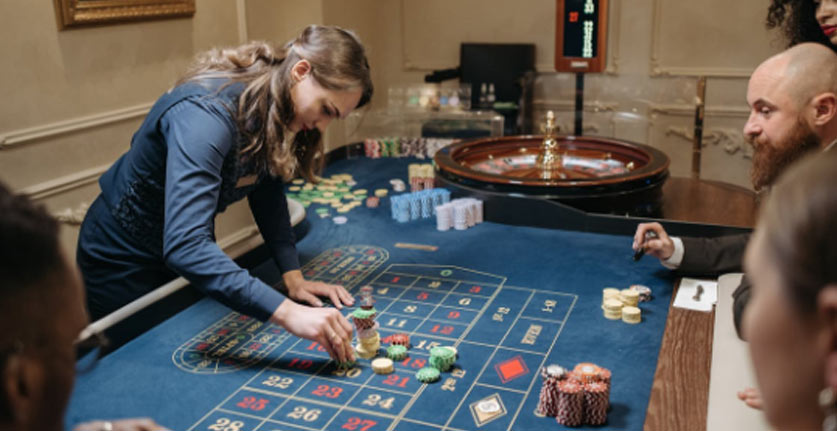Stacia K. from Encinitas, California
Purchased Why Cant I Be Rich Instead Of Good Looking Tank Top.

Explore how gambling halls shape stories in film and literature, from James Bond's high-stakes elegance to Dostoevsky's dark view of obsession and loss.
Few settings have the same mix of glamour and danger as a gambling hall. Writers and filmmakers have leaned on it for decades because everything people love in a story—suspense, character, the possibility of loss—already lives there. One card can turn a fortune. A single spin can decide whether someone walks out rich or ruined. It’s instant drama, and that’s why these places keep showing up in novels and films, from Russian classics to Hollywood blockbusters.
That kind of tension hasn’t gone anywhere. It’s still alive, only the stage looks different now. MONOPOLY Big Baller is a good example of how those old storytelling tricks survive in modern design. Instead of a tuxedoed spy at the baccarat table, you’re on a riverboat with numbered balls dropping from a bingo-style machine. Multipliers suddenly kick in, the action shifts, and a virtual Mr. MONOPOLY guides the whole thing like a host in a show. If you want to get a sense of how it works, you can try live Monopoly Big Baller online . What’s striking isn’t just the look of it—it’s how closely the suspense echoes the way books and films have used gambling scenes for generations. Build the tension, pause, reveal. The formula is old, but it still works.
No character embodies this better than James Bond. Ian Fleming understood the table wasn’t just decoration—it was the perfect stage to show what Bond really was: cold, calculating, but willing to take insane risks if he felt the moment called for it. In Casino Royale , Bond stares across at Le Chiffre, and every card becomes a weapon. Later films swapped baccarat for poker, but the idea stayed the same. The table is combat, only dressed in tuxedos.
Bond’s scenes always stand out because they reveal more than action sequences ever could. When the chips are down, he’s stripped of gadgets and backup. All he has is nerve. That’s what the audience remembers.
Films like Bond usually glamorize the scene, but literature often pulls in the opposite direction. Dostoevsky’s The Gambler is brutal and honest, based on his own struggles with addiction. The table isn’t glamorous—it’s a trap. His characters spin deeper and deeper into obsession, unable to pull away.
Graham Greene’s work often used gambling halls too, but always with moral weight. His characters weren’t sleek spies; they were torn people, fighting with guilt, faith, or temptation. For Greene, the setting wasn’t about elegance but about the slow erosion of conscience.
Here’s how some of the most famous writers used the same stage in very different ways:
|
Author / Work |
Tone of Depiction |
What’s at Stake |
Meaning Behind It |
|
Ian Fleming (Casino Royale) |
Glamorous, sharp |
Bond’s control |
Power and nerve |
|
Dostoevsky (The Gambler) |
Dark, obsessive |
Characters’ ruin |
Addiction, collapse |
|
Graham Greene (various) |
Moral struggle |
Faith, loyalty |
Temptation, guilt |
So why does this setting keep coming back? A few reasons make it irresistible:
Readers and viewers don’t need the rules explained. The moment someone pushes chips forward, we all know: something important is about to happen.

Directors have taken the setting in all directions. Martin Scorsese’s Casino showed the shine but also the rot beneath it—the crime, the machinery, the grit. Ocean’s Eleven spun it into a slick backdrop for clever heists, where chance and planning collided. Even comedies like The Hangover used the table as shorthand for chaos, letting one scene shift an entire story.
Different tones, same idea: the table raises the stakes instantly. Whether for drama, spectacle, or laughs, it works because the risk is universal.
The deeper reason gambling scenes keep showing up is simple: people are fascinated by risk. Stories built around chance feel close to real life. Nobody can control everything. One turn of fate can change everything, and that’s true whether you’re Bond pushing all-in, or a desperate figure in Dostoevsky chasing ruin.
At the core, these scenes ask the same questions:
That tension is what keeps audiences watching, no matter the setting.
These portrayals don’t just reflect reality—they shape how people imagine it. Bond made it glamorous. Dostoevsky made it terrifying. Scorsese made it corrupt. Over time, those images become part of culture itself, influencing how real gambling halls are viewed.
Modern interactive formats borrow from these same beats. The dramatic pause, the host figure, the sudden twist—all of it is drawn straight from literature and cinema. The medium changes, but the storytelling hasn’t.
You must be of legal age and in no violation of local or federal laws while viewing this material.
We do not support misuse of alcohol, including excessive consumption, binge drinking, or drinking and driving. It has been proven that excessive drinking can cause serious physical harm.
Please drink responsibly!
An error occurred while trying to submit the form - we'll do our best to fix it ASAP.
My bad =(
Stacia K. from Encinitas, California
Purchased Why Cant I Be Rich Instead Of Good Looking Tank Top.
 Verified by Provely
Verified by Provely